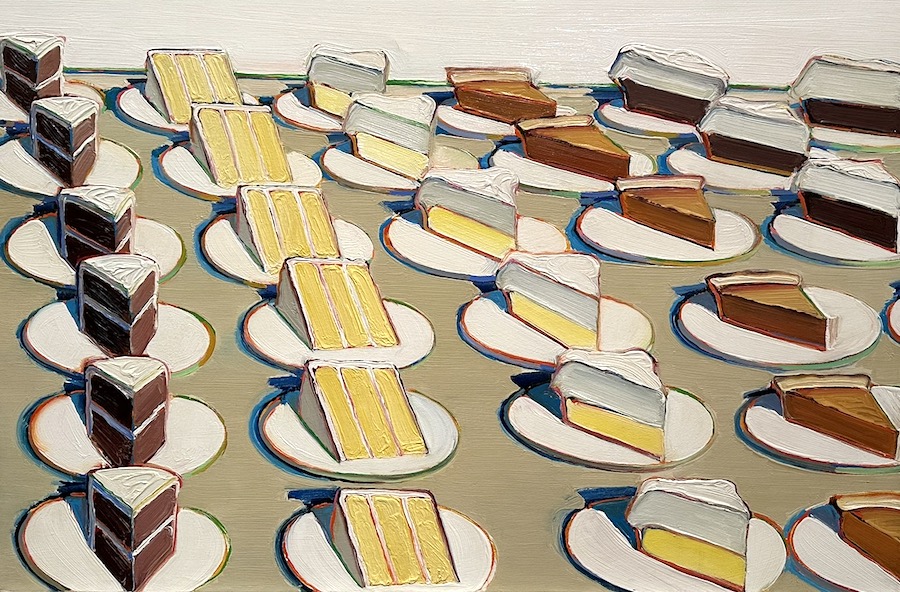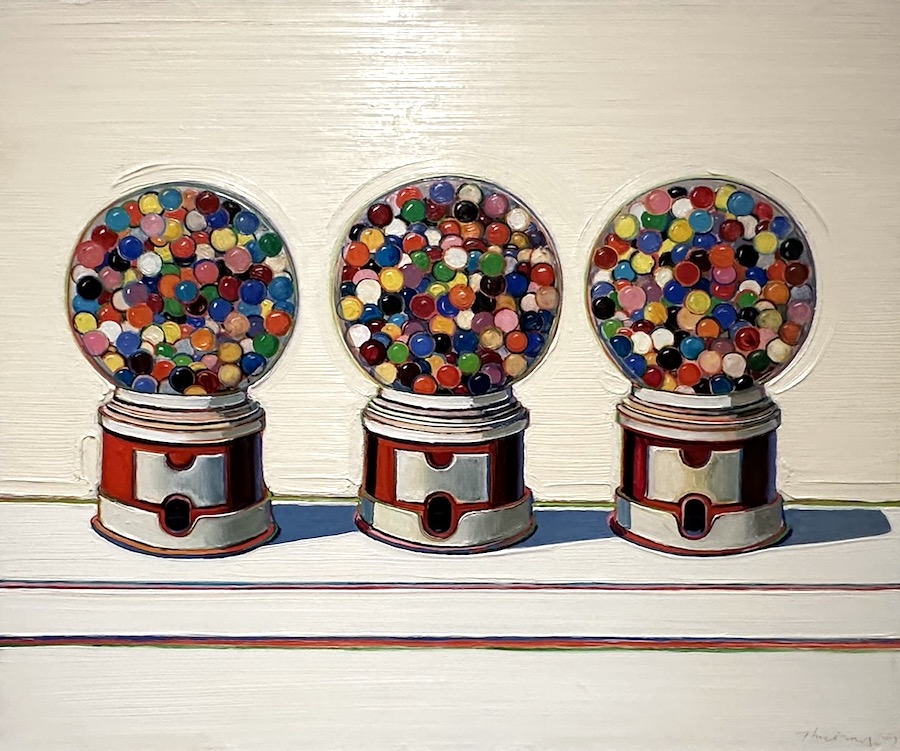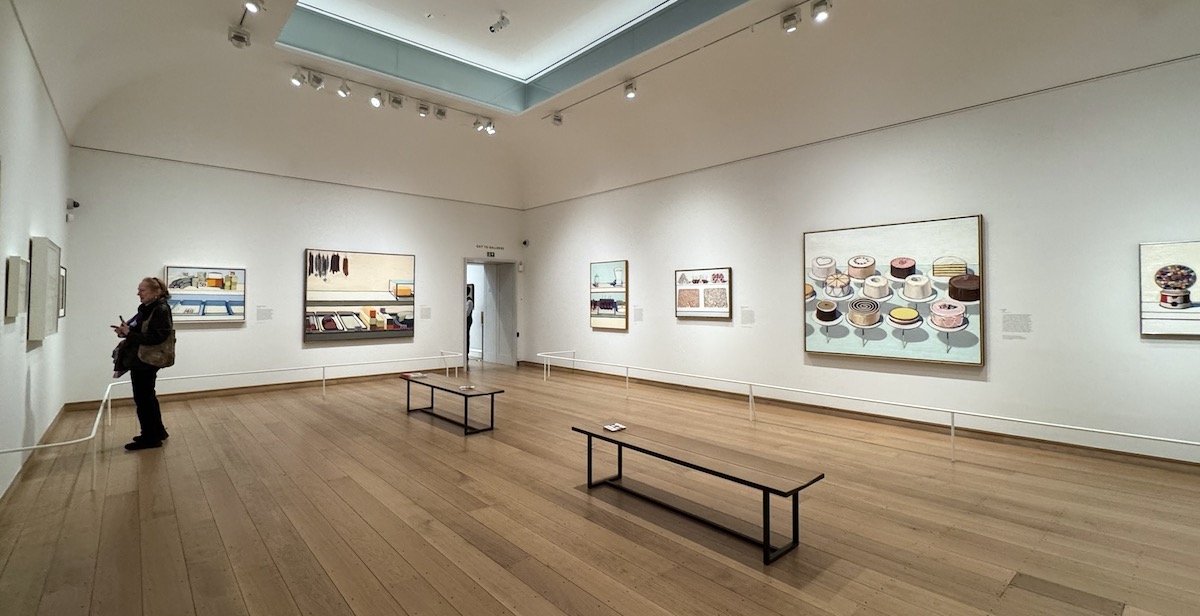Wayne Thiebaud’s first-ever solo exhibition in London at the Courtauld Gallery is a long-awaited event. As an artist, Thiebaud resented being thrown into the Pop art pile. His ambitions were altogether different – to reinvent the still life. He liked the way a painting comes together, and if he did paint the everyday objects of consumerism, his paintings were signals of optimism. This world, built from nothing — out of paint, with light and colour — has a sense of how to put it all together and is like presentational abstraction. Everything is contained by its own conception. Paint + paint = PAINT. Up front and all there, the cornucopia assaults and edifies your visual sense. Major paintings like Four Pinball Machines (1962) and Jackpot Machine (1962) are surreal, otherworldly.

Working and living in Sacramento, California, for much of his life, Thiebaud was a cartoonist, illustrator, and commercial art director, who had a brief stint in animation at Disney Studios and served as a graphic designer for the US Army during the Second World War. All this, before becoming a full-time artist in the 1940s and 1950s. Painted after a visit to New York, Meat Counter (1956-59) is an expressive, experimental mishmash of meats, and its influence comes from de Kooning, who told Thiebaud to paint what you feel when the two met. Pinball Machine (1956) has the same infusion of AbEx energy.
From a jack to a king, Wayne Thiebaud’s fortunes rose with his first successful exhibition in New York with Allan Stone Gallery in 1962. Though the objects of commercial culture were in these paintings, his focus was on diners, bakeries, and stores. Some express an implicit emptiness, the flip side of an unprecedented economic surge.
There is a kind of gentle Cold War optimism to all of Thiebaud’s work, as much an approach as a style. He was obviously committed to art history and the greats, some of whom are displayed in the room adjacent to the main show at the Courtauld – Paul Cézanne, Édouard Manet and Paul Gauguin – were but a few of his mentors—similar ideas of what art as a process involved, but new forms for a new age. Thiebaud’s icons were for an age when growth sprang from a vacuum.

As incredibly optimistic embodiments of an explosive cultural shift in America, Wayne Thiebaud’s paintings sometimes have a sequential, syncopated musical feel, with the pies or lollipops, or whatever, arranged in sequence, with variations that draw us into the incredible surface treatment. He often painted from memory, and under all the frosting and meringue, the totality of his art, seen in this show, is about ways of seeing the visual world as a phenomenon. There is an underlying, abstract, structural ethos to the circles (plates), the triangles (pies), and so on. In Caged Pie (1962), the glass container exists as a purely linear painterly structure, and the pie within is a triangle on a circle. The same goes for the broad green and grey bands that traverse the composition horizontally, binding the cheeses and meats, with hanging sausages in the Delicatessen Counter (1963). Containers, counters, and all manner of shapes are part of the art, as a presentational product world. Thiebaud masterfully displays an ethos of desire. These are visceral tactile scenarios.
As frozen moments in eternal time, Thiebaud’s art wasn’t about flags or symbols, but more about a kind of magic resurgence of the human spirit embodied by pinball machines, cakes, gumball machines, cakes and countertops or ice cream cones. Unlike Claes Oldenburg, whose presentation of Pop subjects (including cake, hamburgers and so on) was real but expanded, Thiebaud takes the painterly on a walk beyond the ordinary. His are near caricatures of the objects he paints, emphatic exaggerations of a spirit of abundance. Thibaud goes past the monotony of Andy Warhol’s Brillo Box aesthetic. His Free cereal box with its green star in Cold Cereal (1961) has an emphatic brilliance. The shadow on the cereal bowl, and the colours, could be out of an Emile Othon Friesz or a Richard Diebenkorn. (Are these interior landscapes of commercial culture?). Similarly, the flotilla of pies in Boston Cremes (1962) saves us from the monotony of the Pop art ethos. While each pie resembles the others at a collective glance, each one is a remarkable variation on the theme.
A drawing and print show in the Courtauld Drawings Gallery accompanies the main show. Often created up to ten years after the paintings and highlighted with pastel, crayon and watercolour, these printworks deviate from the originals. Delights (1965), a spectacular edition of 17 etchings and aquatints produced by Kathy Brown at Crown Point Press in 1964, features small-scale fine-line adaptations of the paintings. Lunch, Fish, Banana Split, Double Decker, Lunch Counter, Gum Machine, Lemon Meringue… the titles tell it all. Cherry Stand is a roadside stall based on Thiebaud’s Fruit Stand painting. Small-scale works in black and white, like Lollipop and Cake Slices, are austere…
Thiebaud’s American Still Life is how it could only have been painted at that time in America. Unlike Jasper Johns’ flags or targets, these painted countertops, butcher shops, or roadside stands have an innocence. It takes such patience to paint the ordinary in such an extraordinary way. It’s a slow game to paint like this, in the flash, boom, zap of the Pop art era. To get the light and colour like that… WOW!
UP FRONT AND ALL THERE – WAYNE THIEBAUD DELIGHTS
Wayne Thiebaud: American Still Life – Courtauld Gallery 10 October 2025 – 18 January 2026

